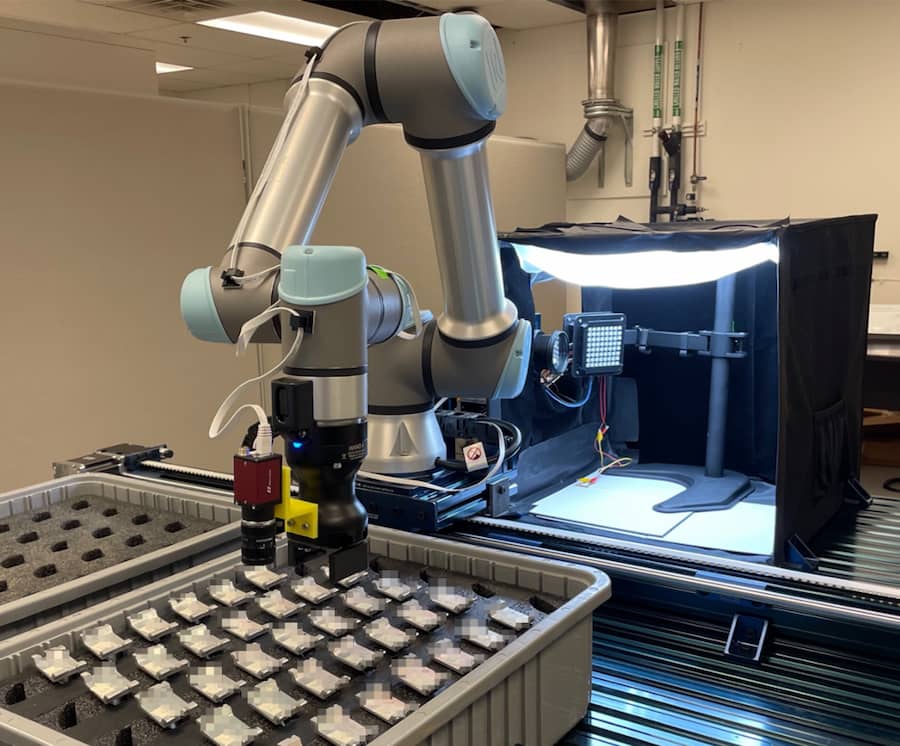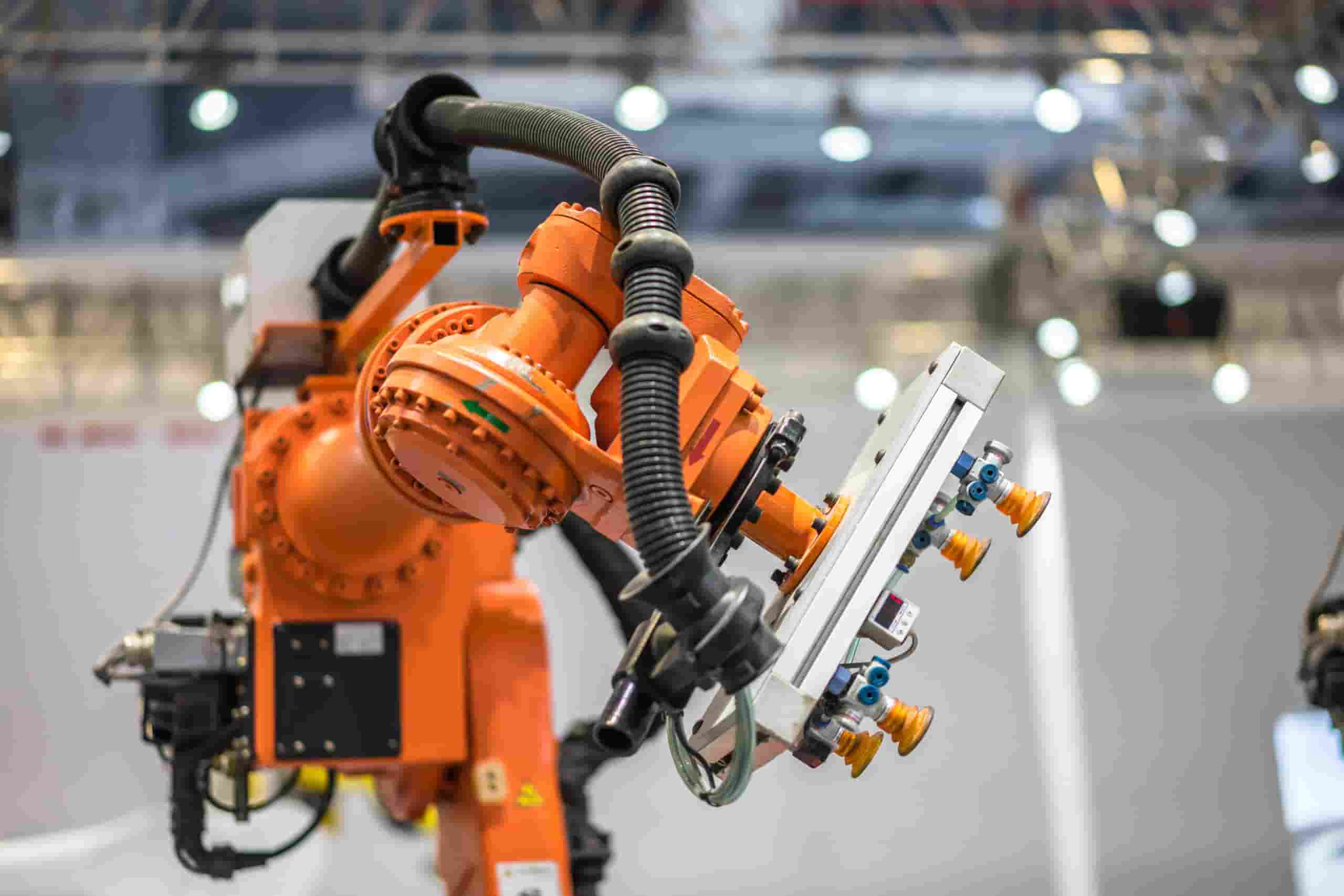The ARM-Funded technology Project “Automated Defect Inspection for Complex Metallic Parts” has yielded impressive results, including detection rates above 95%, a speed of approximately one minute per part, and an expected 345% return on investment if deployed at one site. GKN Aerospace is adopting the technology, and has already built the developed inspection cell in a factory. Learn more about the project and approach in our write-up below!
“Beyond the project, the ARM Institute provided us with a platform to identify challenges and to rethink manufacturing beyond aerospace.” – Xu Chen, Project PI from the University of Washington
Participants
University of Washington (lead institute), University of Connecticut, GKN Aerospace (industry member)
Approach
 Beyond current limits of human inspection, a reliable robotic inspector enables inspection of complex metallic parts at all times of day with no loss in consistency, reduces impacts of human decision fatigue, and will slash manufacturing costs by reducing part escapes. The team’s central innovation is that fusing noncontact imaging data – robotically collected at the right positions and in the right environment – enables high-quality, consistent surface profiling at required operation speeds. From there, machine-learning based data analytics continuously improves inspection performance using accumulated data.
Beyond current limits of human inspection, a reliable robotic inspector enables inspection of complex metallic parts at all times of day with no loss in consistency, reduces impacts of human decision fatigue, and will slash manufacturing costs by reducing part escapes. The team’s central innovation is that fusing noncontact imaging data – robotically collected at the right positions and in the right environment – enables high-quality, consistent surface profiling at required operation speeds. From there, machine-learning based data analytics continuously improves inspection performance using accumulated data.
The first step to such ground-breaking automation is creating the inspection environment to the standards of the most experienced inspectors. The team developed a controlled imaging environment that blocks light contamination to enable accurate and consistent collection of surface profiles. Lens filtering then controls reflections and minimizes glares from the complex part geometry. By respecting fundamental principles of light and reflection, the team then created robotic data collection that reveals not only area defects such as corrosion, but also sub-millimeter machining lines and dents.
Curved geometry disrupts focus and lighting – small defects demand high-resolution macro images. The team’s robotic inspection system automatically partitions and images the part section by section. A bitmasking procedure then extracts only the useful, in-focus areas.
To create the key automation feature for the inspection task, the team built a modular and adaptive system architecture integrating imaging and AI inspection with robot motion control. A software platform centered on the Robotic Operation System, or ROS, ensures flexibility for other industries and extensibility for continued research discoveries.
With controlled-environment data collection, subregion bitmasking, and image preprocessing, the team then built deep transfer learning methods to create the machine intelligence required for high-resolution aerospace inspection.
Results
Using only very limited aerospace data, the team achieved consistent detection rates above 95% – beyond conventional human limits in precision inspection. The developed inspection robot also works at an impressive speed of approximately one minute per part, amplifying the throughput rate by more than three folds. Collectively, the developed robotic inspector is expected to yield a 345% return of investment if deployed at one site. Furthermore, the number is expected to increase to 1870% if the technology is scaled up to 8 sites, or 3012% at 20 sites. The return of investment could be 17 months, or as small as 2 months if scaled to 20 sites.
The team not only engineered automated data collection and the inspection AI to the performance limit, but also made scientific inquiries to create and control the source of illumination, so that even when environmental disturbances occur, lighting remains consistent at the location of the part.
These highlights are only elements from a large set of potentially game-changing impacts. A visual-centric data flow is also immediately interpretable for human-robot collaboration, and traceable to other process steps from machining to polishing, leading to cost-effective implementation and quality assurance in the production of entire engines and aircrafts.
Next Steps
GKN Aerospace is adopting the technology, and has already built the developed inspection cell in a factory on the east coast. The team is in the process of creating multiple additional extension features for adapting the system to other components involving more defect types to classify, larger footprints, and/or welded components.
Full team members: Xu Chen (PI), Santosh Devasia (UW), Jiong Tang (UCONN), Shalabh Gupta (UCONN), Alexander Strzelecki (GKN Aerospace); Andreas Andersson (GKN Aerospace); Martin Philo (GKN Aerospace)
Students and workforce development: Hui Xiao; Abhishek Kulkarni; Mark H Ghali; Michael Gagnier; Jing Yang; Christian Schirmer; Qianyu Zhou
Interested in supporting projects like this one and creating a future where people and robots work together to respond to our nation’s greatest challenges and to develop and produce the world’s most desired products? Email [email protected] to learn more about ARM Institute Membership.
ARM Institute Members can access member-exclusive information about this project by logging into the digital ARM Member Community.
ABOUT THE ARM INSTITUTE
The Advanced Robotics for Manufacturing (ARM) Institute accelerates the development and adoption of robotics technologies that are the foundation of every advanced manufacturing activity today and in the future. The Institute leverages a unique, robust, and diverse ecosystem of partners across industry, academia, and government to make robotics, autonomy, and artificial intelligence more accessible to U.S. manufacturers large and small, train and empower the manufacturing workforce, strengthen the U.S. economy and global competitiveness, and elevate our nation’s security and resilience. Founded in 2017 in Pittsburgh, PA by Carnegie Mellon University and operating as an independent public-private partnership funded by the Department of Defense, ARM is part of the DoD Manufacturing USA® network. Learn more at www.arminstitute.org, follow @ARM_Robotics on Twitter or ARM Institute on LinkedIn.
